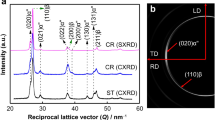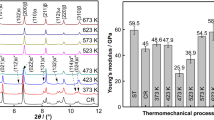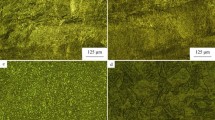Abstract
The influence of heating and cooling routes prior to aging of the Ti–22Nb–6Zr shape memory alloy (at %) on the intensity of formation of the isothermal ωiso phase in the temperature range from 250 to 350°C for 1 and 3 h is studied by X-ray diffraction. It is shown that, for intense formation of the ωiso phase, the most efficient scheme for entering the aging interval includes rapid water cooling water to room temperature from an annealing temperature of 600°C and subsequent rapid heating to an aging temperature of 300°C. All other routes used for entering in the aging interval, including slow cooling and/or heating, do not lead to the formation of an X-ray identifiable amount of the ωiso phase, whereas, the β → ωiso transformation in the temperature range from 250 to 350°C has a pronounced C-shaped kinetics with a maximum at 300°C. Aging in the entire range of 250–350°C leads to the dispersion hardening and an increase in the hardness of the alloy compared to the initial state. Moreover, the hardness gradually increases with an increase in the aging temperature from 250 to 300°C and remains constant in the temperature range of 300–350°C. The β-phase lattice parameter of Ti–22Nb–6Zr alloy remains unchanged over the entire aging temperature range of 250–350°C, which indicates the absence of noticeable diffusional redistribution of elements in the solid solution during the formation of the ωiso phase. The wiso phase formed during the aging of the Ti–22Nb–6Zr alloy over the entire temperature range of 250–350°C has the ratio cω/aω = 0.613 ± 0.002, which is similar to the ratio cω/aω for the shear-type athermal ωath phase, which in turn further emphasizes the identity of these two phase varieties.





Similar content being viewed by others
REFERENCES
Niinomi, M., Mechanical biocompatibilities of titanium alloys for biomedical applications, J. Mech. Behav. Biomed. Mater., 2008, no. 1, pp. 30–42.
Biesiekierski, A., Wang, J., Abdel-Hady Gepreel, M., and Wen, C., A new look at biomedical Ti-based shape memory alloys, Acta Biomater., 2012, no. 8, pp. 1661–1669.
Bönisch, M., Calin, M., Waitz, T., Panigrahi, A., Zehetbauer, M., Gebert, A., Skrotzki, W., and Eckert, J., Thermal stability and phase transformations of martensitic Ti–Nb alloys, Sci. Technol. Adv. Mater., 2013, vol. 14, no. 5, p. 55004.
Aeby-Gautier, E., Settefrati, A., Bruneseaux, F., Appolaire, B., Denand, B., Dehmas, M., Geandier, G., and Boulet, P., Isothermal α″ formation in β metastable titanium alloys, J. Alloys Compd., 2013, no. 577, pp. 5439–5443.
Kim, H.Y., Fu, J., Tobe, H., Kim, J.Il., and Miyazaki, S., Crystal structure, transformation strain, and superelastic property of Ti–Nb–Zr and Ti–Nb–Ta alloys, Shape Mem. Superelasticity, 2015, no. 1, pp. 107–116.
Niinomi, M., Metals for Biomedical Devices, Woodhead Publ., 2019.
Hao, Y.L., Li, S.J., Sun, S.Y., and Yang, R., Effect of Zr and Sn on Young’s modulus and superelasticity of Ti–Nb-based alloys, Mater. Sci. Eng., A, 2006, vol. 441, pp. 112–118.
Kim, J.Il., Kim, H.Y., Inamura, T., Hosoda, H., and Miyazaki, S., Shape memory characteristics of Ti–22Nb-(2-8) Zr (at %) biomedical alloys, Mater. Sci. Eng., A, 2005, no. 403, pp. 334–339.
Gasik, M.M. and Yu, H., Phase equilibria and thermal behavior of the biomedical Ti–Nb–Zr alloy, Mater. Sci., 2009, RM 29. Gasik, M.M. and Yu, H., Phase equilibria and thermal behavior of the biomedical Ti-Nb-Zr alloy, Proc. 17th Plansee Seminar 2009—Int. Conference on High Performance P/M Materials, Reutte, 2009.
Camilo, A., Salvador, F., Opini, V.C., Mello, M.G., and Caram, R., Effects of double-aging heat-treatments on the microstructure and mechanical behavior of an Nb-modified Ti-5553 alloy, Mater. Sci. Eng., A, 2019, vol. 782, pp. 137–142.
Dubinskiy, S., Markova, G., Baranova, A., Vvedenskiy, V., Minkova, I., Prokoshkin, S., and Brailovski, V., A non-typical Elinvar effect on cooling of a beta Ti-Nb–Zr alloy, Mater. Lett., 2022, no. 314, p. 131870.
Li, Q., Niinomi, M., Nakai, M., Cui, Z., Zhu, S., and Yang, X., Effect of Zr on superelasticity and mechanical properties of Ti–24 at % Nb–(0, 2, 4) at % Zr alloy subjected to aging treatment, Mater. Sci. Eng., A, 2012, vol. 536, pp. 197–206.
Wang, K., Wu, D., Wang, D., Deng, Z., Tian, Y., Zhang, L., and Liu, L., Influence of cooling rate on ω phase precipitation and deformation mechanism of a novel metastable β titanium alloy, Mater. Sci. Eng., A, 2022, vol. 829, pp. 142–151.
Tang, X., Ahmed, T., and Rack, H.J., Phase transformations in Ti–Nb–Ta and Ti–Nb–Ta–Zr alloys, J. Mater. Sci., 2000, vol. 35, pp. 1805–1811.
Hickman, B.S., The formation of omega phase in titanium and zirconium alloys: A review, J. Mater. Sci., 1969, vol. 4, pp. 554–563.
Devaraj, A., Williams, A., Nag, S., Srinivasan, R., Fraser, H.L., and Banerjee, R., Three-dimensional morphology and composition of omega precipitates in a binary titanium-molybdenum alloy, Scr. Mater., 2009, vol. 61, pp. 701–704.
Kim, H.Y., Kim, J.I., Inamura, T., Hosoda, H., and Miyazaki, S., Effect of thermomechanical treatment on mechanical properties and shape memory behavior of Ti–(26–28) at % Nb alloys, Mater. Sci. Eng., A, 2006, vols. 438–440, pp. 839–843.
Hao, Y.L., Li, S.J., Sun, S.Y., and Yang, R., Effect of Zr and Sn on Young’s modulus and superelasticity of Ti–Nb-based alloys, Mater. Sci. Eng., A, 2006, vol. 441, pp. 112–118.
Dubinskiy, S.M., Prokoshkin, S.D., Brailovski, V., Inaekyan, K.E., Korotitskiy, A.V., Filonov, M.R., and Petrzhik, M.I., Structure formation during thermomechanical processing of Ti–Nb–(Zr, Ta) alloys and the manifestation of the shape-memory effect, Phys. Met. Metallogr., 2011, vol. 112, pp. 503–516.
Inaekyan, K., Brailovski, V., Prokoshkin, S., Pushin, V., Dubinskiy, S., and Sheremetyev, V., Comparative study of structure formation and mechanical behavior of age-hardened Ti–Nb–Zr and Ti–Nb–Ta shape memory alloys, Mater. Charact., 2015, vol. 103, pp. 65–74.
Dubinskiy, S., Korotitskiy, A., Prokoshkin, S., and Brailovski, V., In situ X-ray diffraction study of athermal and isothermal omega-phase crystal lattice in Ti‒Nb-based shape memory alloys, Mater. Lett., 2016, vol. 168, pp. 155–157.
Funding
The present work has been carried out with the financial support of the Russian Science Foundation, project number 21-73-10167, https://rscf.ru/en/project/21-73-10167/ (thermomechanical treatment and hardness measurement) and the Natural Science and Engineering Research Council of Canada (NSERC) (ingot manufacturing).
Author information
Authors and Affiliations
Corresponding author
Ethics declarations
The authors declare that they have no conflict of interest.
About this article
Cite this article
Dubinskiy, S.M., Baranova, A.P. & Brailovski, V. Influence of Heating and Cooling on the Isothermal β → ω Transition in Ti–22Nb–6Zr Alloy. Russ. J. Non-ferrous Metals 63, 659–663 (2022). https://doi.org/10.3103/S1067821222060050
Received:
Revised:
Accepted:
Published:
Issue Date:
DOI: https://doi.org/10.3103/S1067821222060050




